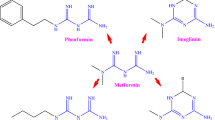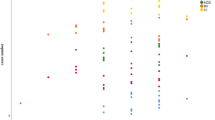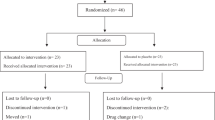Abstract
Aim:
des-O-methyllasiodiplodin (DML) from Cerbera manghas has shown antagonistic activity against mineralocorticoid receptor (MR). Considering the involvement of MR in the insulin tolerance, we attempted to investigate the potential of DML in the treatment of type 2 diabetes mellitus (T2DM).
Methods:
Surface plasmon resonance (SPR) technology and reporter gene-based assays were used to study protein-small molecule interactions. HepG2 and 3T3-L1 cells were treated with H2O2 (0.2 mmol/L) or aldosterone (10 nmol/L) for 24 h. The expression of MR in the cells was downregulated with siRNA. The anti-inflammatory effect of the compound was evaluated, respectively. db/db mice were administered DML (30 mg·kg−1·d−1) for 4 weeks. Serum biochemical parameters and insulin sensitivity were examined. The expression levels of pro-inflammatory cytokines (MCP-1, TNF-α and IL-6) and ROS-related genes (NADPH p47 subunit and transcriptional factor PU.1) in adipose tissues and livers were analyzed using real-time RT-PCR.
Results:
In HepG2 and 3T3-L1 cells, both H2O2 and aldosterone markedly stimulates the expression of MCP-1, TNFα, IL-6, p47 and PU.1 genes. Co-treatment with DML (10 μmol/L) significantly reduced the H2O2- or aldosterone-induced expression of these genes. SPR-based assay confirmed the antagonistic activity of DML against the interaction between SRC-1 and MR-LBD. Furthermore, DML decreased aldosterone-induced MR transcriptional activity in a dose-dependent manner. Downregulation of MR with siRNA in the cells prevented or significantly attenuated aldosterone-stimulated expression of these genes, whereas DML did no longer affect the expression of these genes except that of IL-6. Oral administration of DML effectively reduced the levels of blood glucose and glycosylated hemoglobin (HbA1c) in db/db mice. The treatment also rectified the expression of pro-inflammatory factor and ROS-related genes in db/db mice.
Conclusion:
DML effectively lowers the blood glucose level in db/db mice possibly via ameliorating the expression of obesity-related pro-inflammatory cytokines, highlighting the potential of the marine natural product as a drug lead for the treatment of metabolic disorders.
Similar content being viewed by others
Log in or create a free account to read this content
Gain free access to this article, as well as selected content from this journal and more on nature.com
or
References
Dandona P, Aljada A, Chaudhuri A, Mohanty P, Garg R . Metabolic syndrome: a comprehensive perspective based on interactions between obesity, diabetes, and inflammation. Circulation 2005; 111: 1448–54.
Wellen KE, Hotamisligil GS . Inflammation, stress, and diabetes. J Clin Invest 2005; 115: 1111–9.
Fain JN, Madan AK, Hiler ML, Cheema P, Bahouth SW . Comparison of the release of adipokines by adipose tissue, adipose tissue matrix, and adipocytes from visceral and subcutaneous abdominal adipose tissues of obese humans. Endocrinology 2004; 145: 2273–82.
Kahn SE, Hull RL, Utzschneider KM . Mechanisms linking obesity to insulin resistance and type 2 diabetes. Nature 2006; 444: 840–6.
Harvey AL . Natural products in drug discovery. Drug Discov Today 2008; 13: 894–901.
Kong W, Wei J, Abidi P, Lin M, Inaba S, Li C, et al. Berberine is a novel cholesterol-lowering drug working through a unique mechanism distinct from statins. Nat Med 2004; 10: 1344–51.
Cheenpracha S, Karalai C, Rat APY, Ponglimanont C, Chantrapromma K . New cytotoxic cardenolide glycoside from the seeds of Cerbera manghas. Chem Pharm Bull (Tokyo) 2004; 52: 1023–5.
Chang LC, Gills JJ, Bhat KP, Luyengi L, Farnsworth NR, Pezzuto JM, et al. Activity-guided isolation of constituents of Cerbera manghas with antiproliferative and antiestrogenic activities. Bioorg Med Chem Lett 2000; 10: 2431–4.
Norton TR, Bristol ML, Read GW, Bushnell OA, Kashiwagi M, Okinaga CM, et al. Pharmacological evaluation of medicinal plants from Western Samoa. J Pharm Sci 1973; 62: 1077–82.
Hien TT, Navarro-Delmasure C, Vy T . Toxicity and effects on the central nervous system of a Cerbera odollam leaf extract. J Ethnopharmacol 1991; 34: 201–6.
Jiang CS, Zhou R, Gong JX, Chen LL, Kurtan T, Shen X, et al. Synthesis, modification, and evaluation of (R)-de-O-methyllasiodiplodin and analogs as nonsteroidal antagonists of mineralocorticoid receptor. Bioorg Med Chem Lett 2011; 21: 1171–5.
Funder JW, Krozowski Z, Myles K, Sato A, Sheppard KE, Young M . Mineralocorticoid receptors, salt, and hypertension. Recent Prog Horm Res 1997; 52: 247–60; discussion 61–2.
Kolla V, Robertson NM, Litwack G . Identification of a mineralocorticoid/glucocorticoid response element in the human Na/K ATPase alpha1 gene promoter. Biochem Biophys Res Commun 1999; 266: 5–14.
Snyder PM, Price MP, McDonald FJ, Adams CM, Volk KA, Zeiher BG, et al. Mechanism by which Liddle's syndrome mutations increase activity of a human epithelial Na+ channel. Cell 1995; 83: 969–78.
Ferrari P, Ferrandi M, Tripodi G, Torielli L, Padoani G, Minotti E, et al. PST 2238: A new antihypertensive compound that modulates Na,K-ATPase in genetic hypertension. J Pharmacol Exp Ther 1999; 288: 1074–83.
Conn JW . Hypertension, the potassium ion and impaired carbohydrate tolerance. N Engl J Med 1965; 273: 1135–43.
Shimamoto K, Shiiki M, Ise T, Miyazaki Y, Higashiura K, Fukuoka M, et al. Does insulin resistance participate in an impaired glucose tolerance in primary aldosteronism? J Hum Hypertens 1994; 8: 755–9.
Hitomi H, Kiyomoto H, Nishiyama A, Hara T, Moriwaki K, Kaifu K, et al. Aldosterone suppresses insulin signaling via the downregulation of insulin receptor substrate-1 in vascular smooth muscle cells. Hypertension 2007; 50: 750–5.
Fallo F, Veglio F, Bertello C, Sonino N, Della Mea P, Ermani M, et al. Prevalence and characteristics of the metabolic syndrome in primary aldosteronism. J Clin Endocrinol Metab 2006; 91: 454–9.
Mosso LM, Carvajal CA, Maiz A, Ortiz EH, Castillo CR, Artigas RA, et al. A possible association between primary aldosteronism and a lower beta-cell function. J Hypertens 2007; 25: 2125–30.
Haluzik M, Sindelka G, Widimsky J Jr, Prazny M, Zelinka T, Skrha J . Serum leptin levels in patients with primary hyperaldosteronism before and after treatment: relationships to insulin sensitivity. J Hum Hypertens 2002; 16: 41–5.
Giacchetti G, Ronconi V, Turchi F, Agostinelli L, Mantero F, Rilli S, et al. Aldosterone as a key mediator of the cardiometabolic syndrome in primary aldosteronism: an observational study. J Hypertens 2007; 25: 177–86.
Zennaro MC, Caprio M, Feve B . Mineralocorticoid receptors in the metabolic syndrome. Trends Endocrinol Metab 2009; 20: 444–51.
Guo C, Martinez-Vasquez D, Mendez GP, Toniolo MF, Yao TM, Oestreicher EM, et al. Mineralocorticoid receptor antagonist reduces renal injury in rodent models of types 1 and 2 diabetes mellitus. Endocrinology 2006; 147: 5363–73.
Joffe HV, Kwong RY, Gerhard-Herman MD, Rice C, Feldman K, Adler GK . Beneficial effects of eplerenone versus hydrochlorothiazide on coronary circulatory function in patients with diabetes mellitus. J Clin Endocrinol Metab 2007; 92: 2552–8.
Matsumoto S, Takebayashi K, Aso Y . The effect of spironolactone on circulating adipocytokines in patients with type 2 diabetes mellitus complicated by diabetic nephropathy. Metabolism 2006; 55: 1645–52.
Takebayashi K, Matsumoto S, Aso Y, Inukai T . Aldosterone blockade attenuates urinary monocyte chemoattractant protein-1 and oxidative stress in patients with type 2 diabetes complicated by diabetic nephropathy. J Clin Endocrinol Metab 2006; 91: 2214–7.
Bianchi S, Bigazzi R, Campese VM . Long-term effects of spironolactone on proteinuria and kidney function in patients with chronic kidney disease. Kidney Int 2006; 70: 2116–23.
Callera GE, Touyz RM, Tostes RC, Yogi A, He Y, Malkinson S, et al. Aldosterone activates vascular p38MAP kinase and NADPH oxidase via c-Src. Hypertension 2005; 45: 773–9.
Pitt B, Remme W, Zannad F, Neaton J, Martinez F, Roniker B, et al. Eplerenone, a selective aldosterone blocker, in patients with left ventricular dysfunction after myocardial infarction. N Engl J Med 2003; 348: 1309–21.
Wada T, Kenmochi H, Miyashita Y, Sasaki M, Ojima M, Sasahara M, et al. Spironolactone improves glucose and lipid metabolism by ameliorating hepatic steatosis and inflammation and suppressing enhanced gluconeogenesis induced by high-fat and high-fructose diet. Endocrinology 2010; 151: 2040–9.
Guo C, Ricchiuti V, Lian BQ, Yao TM, Coutinho P, Romero JR, et al. Mineralocorticoid receptor blockade reverses obesity-related changes in expression of adiponectin, peroxisome proliferator-activated receptor-gamma, and proinflammatory adipokines. Circulation 2008; 117: 2253–61.
Hirata A, Maeda N, Hiuge A, Hibuse T, Fujita K, Okada T, et al. Blockade of mineralocorticoid receptor reverses adipocyte dysfunction and insulin resistance in obese mice. Cardiovasc Res 2009; 84: 164–72.
Lin Z, Shen H, Huang J, Chen S, Chen L, Chen J, et al. Butyl 4-(butyryloxy)benzoate functions as a new selective estrogen receptor beta agonist and induces GLUT4 expression in CHO-K1 cells. J Steroid Biochem Mol Biol 2008; 110: 150–6.
Liu Q, Zhang Y, Lin Z, Shen H, Chen L, Hu L, et al. Danshen extract 15,16-dihydrotanshinone I functions as a potential modulator against metabolic syndrome through multi-target pathways. J Steroid Biochem Mol Biol 2010; 120: 155–63.
Xu H, Barnes GT, Yang Q, Tan G, Yang D, Chou CJ, et al. Chronic inflammation in fat plays a crucial role in the development of obesity-related insulin resistance. J Clin Invest 2003; 112: 1821–30.
Dandona P, Aljada A, Bandyopadhyay A . Inflammation: the link between insulin resistance, obesity and diabetes. Trends Immunol 2004; 25: 4–7.
Li SL, Valente AJ, Zhao SJ, Clark RA . PU.1 is essential for p47(phox) promoter activity in myeloid cells. J Biol Chem 1997; 272: 17802–9.
Kobayashi N, Yoshida K, Nakano S, Ohno T, Honda T, Tsubokou Y, et al. Cardioprotective mechanisms of eplerenone on cardiac performance and remodeling in failing rat hearts. Hypertension 2006; 47: 671–9.
Miyata K, Rahman M, Shokoji T, Nagai Y, Zhang GX, Sun GP, et al. Aldosterone stimulates reactive oxygen species production through activation of NADPH oxidase in rat mesangial cells. J Am Soc Nephrol 2005; 16: 2906–12.
Garthwaite SM, McMahon EG . The evolution of aldosterone antagonists. Mol Cell Endocrinol 2004; 217: 27–31.
Fagart J, Hillisch A, Huyet J, Barfacker L, Fay M, Pleiss U, et al. A new mode of mineralocorticoid receptor antagonism by a potent and selective nonsteroidal molecule. J Biol Chem 2010; 285: 29932–40.
Callera GE, Yogi A, Briones AM, Montezano AC, He Y, Tostes RC, et al. Vascular proinflammatory responses by aldosterone are mediated via c-Src trafficking to cholesterol-rich microdomains: role of PDGFR. Cardiovasc Res 2011; 91: 720–31.
Fu M, Sun T, Bookout AL, Downes M, Yu RT, Evans RM, et al. A nuclear receptor atlas: 3T3-L1 adipogenesis. Mol Endocrinol 2005; 19: 2437–50.
Liu G, Grifman M, Keily B, Chatterton JE, Staal FW, Li QX . Mineralocorticoid receptor is involved in the regulation of genes responsible for hepatic glucose production. Biochem Biophys Res Commun 2006; 342: 1291–6.
Lee YS, Shin S, Shigihara T, Hahm E, Liu MJ, Han J, et al. Glucagon-like peptide-1 gene therapy in obese diabetic mice results in long-term cure of diabetes by improving insulin sensitivity and reducing hepatic gluconeogenesis. Diabetes 2007; 56: 1671–9.
Saltiel AR, Kahn CR . Insulin signalling and the regulation of glucose and lipid metabolism. Nature 2001; 414: 799–806.
Acknowledgements
We are grateful to Dr Mayumi NISHI for providing the GFP-rMR vector and Dr Gordon HAGER for the GFP-GR plasmid (pCI-nGFP-C656G).
This work was supported by the National Marine 863 Programme (grant 2011AA09070102), the National Natural Science Foundation of China (grants 81173105 and 91213306), the National Science and Technology Major Project (grants 2012ZX09301001-004 and 2012ZX09103101-18), the Foundation of Chinese Academy of Sciences (grant KSCX2-EW-Q-3) and the Science Foundation of Shanghai (grant 11XD1406100).
Author information
Authors and Affiliations
Corresponding authors
Additional information
(Supplementary information is available at the Acta Pharmacologica Sinica website.
Supplementary information
Supplementary data
Blood serum bio-chemical analysis. (DOC 2926 kb)
Rights and permissions
About this article
Cite this article
Zhou, R., Lin, Zh., Jiang, Cs. et al. Marine natural product des-O-methyllasiodiplodin effectively lowers the blood glucose level in db/db mice via ameliorating inflammation. Acta Pharmacol Sin 34, 1325–1336 (2013). https://doi.org/10.1038/aps.2013.47
Received:
Accepted:
Published:
Issue date:
DOI: https://doi.org/10.1038/aps.2013.47
Keywords
This article is cited by
-
Chemical Constituents of Litsea euosma
Chemistry of Natural Compounds (2019)
-
Medicinal properties of Hericium erinaceus and its potential to formulate novel mushroom-based pharmaceuticals
Applied Microbiology and Biotechnology (2014)



